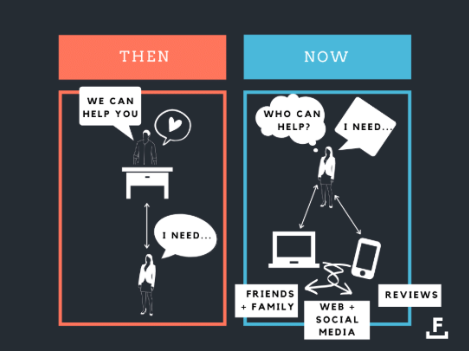Article's Content
If you haven’t invested in developing a persona yet—this is the post for you.
There are typically two reasons why B2B SaaS businesses do not invest in the development of personas:
1. They are “bootstrapping it.” It’s early days and they are moving too fast to stop and learn about their customers in great detail.
OR
2. My personal favourite—they believe everyone on the team knows who they are marketing to, so why should they waste time documenting it?

Sorry, that’s just not a good take.
In this post, I’m going to explain why you should care about developing personas and outline six steps to help your brand get started.
Make 2021 The Year Of The Customer
Over the last five years, B2B marketers have impressively adopted new technologies to automate business and marketing.
Finding ways to conduct business more efficiently is a goal of every business, especially SaaS brands. While this adoption of technology has helped many brands move forward, you won’t get far if you’re not listening to your customers.
In their Predictions 2020: B2B Marketing and Sales Report, Forester reveals a few statistics that clearly demonstrate the struggle to market to customers based on actual customer needs.
For example:
- 47% of those surveyed said customer needs actually drove their marketing strategies
- 40% of those surveyed said they focus on solving customers’ problems vs. promoting their products
Yikes. That’s less than half.

How can your brand market a solution without understanding how it solves a problem for your target customers? Is it a problem your customers even care about?
Creating marketing personas will pay dividends by:
- Building a relevant relationship with your customers
- Giving your internal team confidence when making decisions
If that doesn’t convince you, an articles from Stephen Zoeller reveals that 71% of companies who exceed revenue and lead goals have documented personas.
Now that’s worth thinking about.

Personas Remain A Heavyweight In Marketing
Alan Cooper is credited with creating the first persona to help him build software that would assist project managers.
That was decades ago.
I was introduced to personas early on in my career, and I’m still a staunch supporter of the need to stop and appreciate the perspective of customers. I often ask our clients…
“How would your customers describe the problem? And how would your customers describe the value your business offers?”
A persona is a representation of your customer base—it brings your customers’ pain points, needs, perspectives, and challenges all together in the context of a character’s life. Some businesses have one persona and some have multiple.
Over the years, marketers have started to create customer avatars or customer profiles all of which are forms of customer personas. I’m a fan of them all because they are all about better understanding your customers’ needs.
Personas have expanded over the years to adapt to all the different customer touchpoints, the increase in customer expectations and the need for brand authenticity. How customers buy from and interact with brands has changed. Previously, marketing centered on creating a single stimulus that resonated with a customer (driven by a single insight) and triggered their emotive need to buy.
Now, brands must create multiple stimuli to respond to multiple pain points, while contending with multiple sources of information and multiple competitors. Google’s ZMOT (Zero Moment of Truth) theory describes this change in the simplest way I’ve seen.
Customers conduct research, gain perspective from others and determine the value of your brand without ever having direct contact with your business. This extended process has impacted the approach to persona development by giving marketers multiple avenues to research and understand.

Oh, and this shift in buyer behaviour has happened in B2B too.
What does that mean for you?
It means you need to really understand your customers before creating any marketing content, because your content might be potential buyers’ first (and most decisive) experience with your brand.
So let’s go through six simple steps for creating a persona that will help your B2B brand understand your customers’ pain points, stimuli, sources of information and more.
How Do You Create A B2B Persona?
Step 1: Identify Your Persona Or Personas
To help your customers solve their problem and to present your brand as the winning solution, you need to speak to your specific audience—which means your persona should be as detailed as possible.
For example, let’s say your product or service targets lawyers such as billing software for law firms. You’re probably not marketing to all lawyers, right? In reality, it’s a smaller group—say, lawyers who service large corporations in North America and who specialize in certain areas of law.
So how do you narrow down your target audience?
✅ Invite your sales, marketing, operations and customer success teams to a meeting.
✅ Ask the team: “Who is buying from us now? Is there a segment within our customer base who gets the most value from our product or service?” Don’t be surprised if your primary persona is not your largest customer base today.
Step 2: Determine Research Opportunities
The best source of information about your customers is—shockingly—your customers. You need to talk to customers on a regular basis. You can also learn a lot from secondary sources, but this research is best paired with insights directly from your customers.
Create a list of all of the research avenues available to your business.
This research list should include:
✅ Customer interviews (start with at least 10) and scale based on your business
✅ Surveys, which allow you to reach a wider customer group
✅ Customer feedback provided by your sales team
✅ Website and social analytics data, which can help you understand the demographics of your audience and what content they’re most interested in
✅ Social groups where your customers spend time
✅ Review sites like G2 and Capterra, where you can find out what customers are saying about your products—and your competitors’
Step 3: Prepare Questions
Arguably the hardest part of the process is determining what questions to ask, what topics to research and what insights will be most valuable to your brand. After all, the information you collect will have a direct impact on the quality of your persona.
Here are some topics to get you started, but you may want to call in a professional to help you:
✅ Basic demographics
✅ A day in the customer’s life
✅ Their pain points
✅ Their awareness of solutions
✅ Where they look for help
✅ The urgency of the problem
✅ Their perspective on your brand’s solution
✅ How they evaluate solutions
✅ What influences their decision-making
✅ The challenges or barriers that get in the way of decision-making
Step 4: Collect Research
WAIT!
Before you start gathering information, determine how you will collect and store it. This could be as basic as a spreadsheet or Word document. There are programs that you can collect and store customer research in such as Artifact.
Here are a few tips:
✅ Meeting with customers can be time-consuming, as interviews typically take 30–45 minutes apiece. It’s best to conduct these over video chat because video allows for that in-person dynamic, and you can record your conversations to revisit when writing your persona.
✅ Surveys can be conducted through many free tools; for example, Survey Monkey and SurveyKing are easy to use and offer tips for crafting your questions.
✅ If you find interesting information on a review site or social media channel, take a screengrab and make a note of why you feel this info is important. Collect these screengrabs all in one document. Or, instead of taking a screengrab, use a tool that allows you to extract the data you find into a spreadsheet
Step 5: Create The Persona
When all your avenues of research have been explored, start looking for patterns within your research, and you will see a character emerge.
The research you collected should lead the way, so if you don’t feel confident in your persona, then you likely need to go back to step 3 and try again.
Think of your persona as a story you’re telling on behalf of someone else.
✅ Give your persona a name.
✅ Summarize their pain point(s) with one quote.
✅ Describe their day.
✅ Be detailed and specific.
✅ Connect the persona’s problem to your brand and solution.
✅ Describe the persona’s perspective on the available solutions and what they need in order to validate a decision in your brand’s favour.
Step 6: Share Internally
Personas should inspire the entire team, not just the marketing team. Everyone in the organization should have a detailed understanding of who they are helping and the confidence to make decisions in your customers’ best interests.
This kind of confidence is invaluable because your entire team is on the same page and understands the needs of your persona in detail.

Wrapping This Up
Once you’ve created your persona, you’re not done—you have to continuously evolve your persona based on customer interviews, industry changes and your own growth as an organization.
As your brand moves into new markets, you need to be able to create content, tell stories and connect with a new audience. Personas are a great starting point to ensure that your whole team and your messaging is aligned regarding the audience you’re trying to reach.
So if you start with one or two personas in the early days, you could very well end up with a handful of personas as you grow and begin to serve new clientele.
Our team at Foundation recently created a short questionnaire to help get the creative juices flowing as you build your persona.
Try it out, and if you have any questions about creating a persona, don’t hesitate to reach out—we’re always happy to chat.
[Updated Dec 02, 2020]








